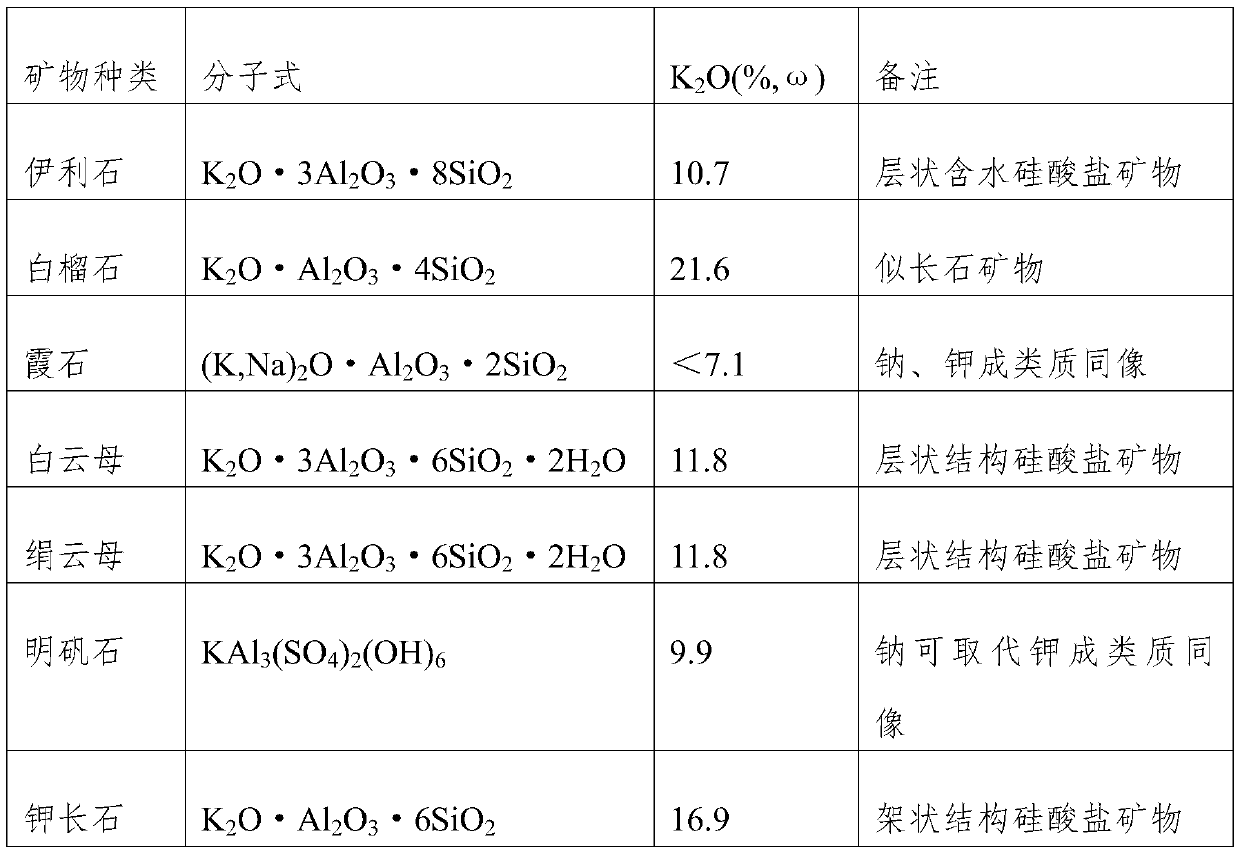Method for extracting potassium in potassium-containing rock
An extraction method, potassium rock technology, applied in the direction of improving process efficiency, etc., can solve the problems of waste of wet chemical raw materials, difficult by-product sewage discharge, long production cycle, etc., to reduce sewage discharge and heat energy consumption, and shorten processing time , Improve the effect of potassium dissolution rate
- Summary
- Abstract
- Description
- Claims
- Application Information
AI Technical Summary
Problems solved by technology
Method used
Image
Examples
Embodiment 1
[0030] A method for extracting potassium in potassium-containing rocks, comprising the steps of:
[0031] 1) Primary calcination: crush the potassium-containing rock to 200 mesh, add bone meal and carbon powder according to the ratio of potassium-containing rock: bone meal: carbon powder = 100:3:23, and place it at a temperature of 700°C for 1 hour of calcination;
[0032] 2) cooling: cooling the primary calcined product to room temperature;
[0033] 3) Ultrasonic reaction: Mix the cooled product with the acid solution according to the mass ratio of solid-liquid ratio of 1:1.5, place in an ultrasonic reactor and control the temperature of the material at 100°C for 50 minutes of reaction. After the reaction, the solid-liquid is separated to obtain a solid;
[0034] 4) Microwave reaction: Mix the ultrasonic reaction product and additives according to the mass ratio of solid-to-liquid ratio of 1:1.7, and place them in a microwave reactor to control the material temperature at 130...
Embodiment 2
[0043] A method for extracting potassium in potassium-containing rocks, comprising the steps of:
[0044] 1) Primary calcination: crush the potassium-containing rock to 80 meshes, add bone meal and carbon powder according to the ratio of potassium-containing rock: bone meal: carbon powder = 100:1:21, and place it at 600°C for calcination for 0.5h;
[0045] 2) cooling: cooling the primary calcined product to room temperature;
[0046] 3) Ultrasonic reaction: Mix the cooled product and the acid solution according to the mass ratio of solid-liquid ratio of 1:1.2, place in an ultrasonic reactor to control the temperature of the material at 80°C and react for 30 minutes. After the reaction, the solid-liquid is separated to obtain a solid;
[0047] 4) Microwave reaction: Mix the ultrasonic reaction product and additives according to the mass ratio of solid-to-liquid ratio of 1:1.3, and place them in a microwave reactor to control the material temperature at 120°C for 30 minutes;
...
Embodiment 3
[0056] A method for extracting potassium in potassium-containing rocks, comprising the steps of:
[0057] 1) Primary calcination: crush the potassium-containing rock to 100 mesh, add bone meal and carbon powder according to the ratio of potassium-containing rock: bone meal: carbon powder = 100:2:22, and place it at 650°C for calcination for 0.8h;
[0058] 2) cooling: cooling the primary calcined product to room temperature;
[0059] 3) Ultrasonic reaction: Mix the cooled product with the acid solution according to the mass ratio of solid-to-liquid ratio of 1:1.3, place in an ultrasonic reactor to control the temperature of the material at 90°C for 40 minutes, and separate the solid and liquid after the reaction to obtain a solid;
[0060] 4) Microwave reaction: Mix the ultrasonic reaction product and additives according to the mass ratio of solid to liquid ratio of 1:1.5, and place them in a microwave reactor to control the temperature of the material at 125°C for 40 minutes; ...
PUM
| Property | Measurement | Unit |
|---|---|---|
| power | aaaaa | aaaaa |
Abstract
Description
Claims
Application Information
 Login to View More
Login to View More - R&D
- Intellectual Property
- Life Sciences
- Materials
- Tech Scout
- Unparalleled Data Quality
- Higher Quality Content
- 60% Fewer Hallucinations
Browse by: Latest US Patents, China's latest patents, Technical Efficacy Thesaurus, Application Domain, Technology Topic, Popular Technical Reports.
© 2025 PatSnap. All rights reserved.Legal|Privacy policy|Modern Slavery Act Transparency Statement|Sitemap|About US| Contact US: help@patsnap.com

